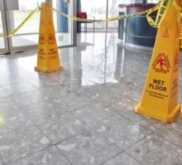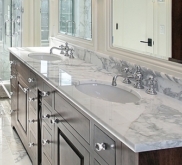Expert Advice
From a Restorative Perspective…
The intent of these articles is to give a technical perspective to the most common questions and concerns our customers may have. We strive to be as objective as possible and to provide information based on fact and professional experience. In no way will we be held liable for the advice provided herein.
Expert advice can only be obtained through an onsite visit and inspection of the stone surfaces as many variables come into play such as the type of stone, existing sealers, quality of installation, finishes, etc. MARBLEMaster is pleased to provide free technical advice during onsite estimates.
Defective Acrylic Coating
- October 15, 2021
- Before and After, Expert Advice, Residential
- Admin
- Comments Off on Defective Acrylic Coating

Many years ago, it was quite common to find marble dining tables covered with a very durable acrylic coating. Today, this trend seems to be making its way back for the simple reason that furniture manufacturers are often faced with customers who don’t know how to care for their stone. This fairly new dining table […]
Read moreThe Truth Behind “Factory-Sealed” Counter Tops
- December 15, 2020
- Expert Advice
- Admin
- Comments Off on The Truth Behind “Factory-Sealed” Counter Tops

Many consumers often misinterpret the term widely used in the counter fabrication industry known as “factory sealed” and believe that their brand new counter top has actually been chemically sealed. When a stone is mined in a quarry, it is typically rough in appearance. At this point, the stone is quite porous and easily absorbs […]
Read moreAltering the Finish – Marble in a Kitchen
- December 5, 2018
- Before and After, Expert Advice, Residential
- Admin
- Comments Off on Altering the Finish – Marble in a Kitchen

Occasionally, a homeowner may find that the stone they originally purchased is not living up to their expectations. Many factors can affect your long-term enjoyment: Lighting: On a highly polished stone surface, an adjacent window with lots of natural sunlight can reflect tons of light and create that mirror-like surface that speaks luxury and wealth; […]
Read moreAnti-Slip Treatments
- December 1, 2017
- Expert Advice, Uncategorized
- Admin
- Comments Off on Anti-Slip Treatments

For many property owners and managers of commercial sites, slips and falls on wet or dry surfaces can result in a huge economical loss, lawsuits and a lot of pain and suffering for the injured party. It is quite common for a floor surface, originally deemed safe, to become unsafe due to constant exposure to […]
Uneven Tile Installation – Correcting Lippage
- September 29, 2017
- Expert Advice
- Admin
- Comments Off on Uneven Tile Installation – Correcting Lippage

Occasionally, we come across a brand new stone tile installation where the tiles are not level, or simply one tile is laid higher than other adjacent tiles creating a level of lippage which is unacceptable by the homeowner or even by industry standards. In the image above, although the level of lippage seems minimal, it […]
Read moreGet the Most Enjoyment out of your Marble & Granite
- February 15, 2014
- Expert Advice, Uncategorized
- Admin
- Comments Off on Get the Most Enjoyment out of your Marble & Granite

More often than not, homeowners invest in gorgeous granite counters and pristine marble foyers and fail to take simple measures to maintain these natural stone installations in the years that follow. While granite and marble are known for their durability, these materials can develop scratches, chips, stains, and even cracks over time. Their lustre can […]
Read moreKitchen Sinks – Undermount vs Overmount
- November 3, 2012
- Expert Advice
- Admin
- Comments Off on Kitchen Sinks – Undermount vs Overmount

From an interior design perspective, the undermount sink has been gaining in popularity especially when installing natural stone countertops such as granite and quartz. And it’s easy to understand why. Not only do they make clean up easier, allowing homeowners to quickly wipe debris into the sink without getting caught under a lip (of an […]
Read moreStone Care Do’s and Don’ts
- July 5, 2012
- Expert Advice
- Admin
- Comments Off on Stone Care Do’s and Don’ts

Do have your natural stone treated with an appropriate sealant before use. wipe up spills as quickly as possible to avoid damage and staining. use trivets or mats under hot dishes and cookware. use a cutting board to avoid scratching the surface. place a small rug or mat at entrances to trap dirt and sand […]
Read moreFinishes – Honed vs Polished
- March 3, 2012
- Expert Advice
- Admin
- Comments Off on Finishes – Honed vs Polished

If you’re contemplating restoration or have a new installation that you’re not quite satisfied with, you will be pleased to learn that the finish is not written in stone. It can be changed with a little effort and expertise. Most often, during restoration, the existing finish is removed entirely through the grinding process. At this […]
Read moreImportant Links
Recent Posts
- Defective Coating on Marble Dining Table
- Defective Acrylic Coating
- The Truth Behind “Factory-Sealed” Counter Tops


